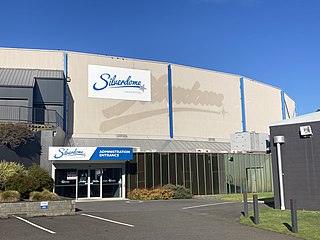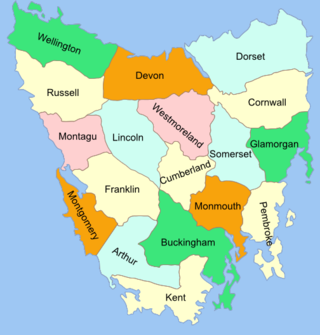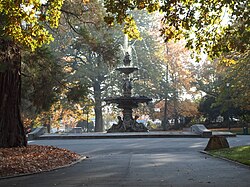
Launceston or is a city in the north of Tasmania, Australia, at the confluence of the North Esk and South Esk rivers where they become the Tamar River (kanamaluka). As of 2021, the Launceston urban area has a population of 90,953. Launceston is the second most populous city in Tasmania after the state capital, Hobart. As of 2020, Launceston is the 18th largest city in Australia. Launceston is the fifth-largest inland city and the ninth-largest non-capital city in Australia. Launceston is regarded as the most livable regional city, and was one of the most popular regional cities to move to in Australia from 2020 to 2021. Launceston was named Australian Town of the Year in 2022.
The history of Tasmania begins at the end of the Last Glacial Period when it is believed that the island was joined to the Australian mainland. Little is known of the human history of the island until the British colonisation of Tasmania in the 19th century.

The Silverdome, Australia's first indoor velodrome, is an indoor sporting and entertainment venue located in Launceston, Tasmania built in 1984. The Silverdome was built at an estimated cost of A$4 million, as the Tasmanian Government "proposed a world class facility" to replace the run down velodrome in the Launceston suburb of St Leonards. In January 1985, the facility's opening coincided with the City of Launceston Cycling Club Championships. Although "custom built for cycling", the Silverdome has hosted various concerts and other sporting events. The Collingwood Magpies Netball team, who compete in the Suncorp Super Netball league, have played a home match each season at the venue.

The Cataract Gorge is a river gorge in Launceston, Tasmania, Australia, approximately 1.5 km from the city centre. It is one of the region's premier tourist attractions with a Cataract Gorge boat trip leaving from Home Point Parade. It is found at the lower section of the South Esk River.

Davey Street a major one way street passing through the outskirts of the Hobart City Centre in Tasmania, Australia. Davey street is named after Thomas Davey, the first Governor of Van Diemen's Land. The street forms a one-way couplet with nearby Macquarie Street connecting traffic from the Southern Outlet in the south with traffic from the Tasman Highway to the east and the Brooker Highway to the north of the city. With annual average daily traffic of 37,200, the road is one of the busier streets in Hobart.

Carrick is a small historic village 17 kilometres (11 mi) west of Launceston, Tasmania, Australia, on the banks of the Liffey River. The Meander Valley Highway passes through the town's centre; this road was formerly the main road from Launceston to Deloraine and Devonport. Carrick has a well-preserved 19th-century heritage; fifteen of its colonial buildings are listed on the Tasmanian Heritage Register including Carrick House (1840), St Andrew's Church (1848), the Old Watch house (1837), Monds Roller Mill (1846) and the Carrick Hotel (1833).

The Rev. John West emigrated from England to Van Diemen's Land in 1838 as a Colonial missionary, and became pastor of an Independent (Congregational) Chapel in Launceston's St. John's Square. He also co-founded The Examiner newspaper in 1842 and was later editor of The Sydney Morning Herald.

The Australasian Anti-Transportation League was a body established to oppose penal transportation to Australia. Beginning in Van Diemen's Land (Tasmania) in the late 1840s, it had branches in Adelaide, Melbourne, Sydney, and Canterbury. The Colonial Office abandoned transportation to eastern Australia in 1852.

The Lands administrative divisions of Tasmania are the divisions of Tasmania into land districts and parishes for cadastral purposes, which are part of the lands administrative divisions of Australia. There are 20 land districts in Tasmania, although in the early nineteenth century there were several other systems, with 18 or 36 counties and 9 other divisions used, as well as hundreds. The land districts include the 18 former counties of the island of Tasmania which were renamed but retain the same boundaries, plus King Island and Flinders Island. The counties are referenced in the 1911 Encyclopædia Britannica, with Hobart described as being in Buckingham County, Launceston in Cornwall County and Beaconsfield in Devon County. The land districts are used for land titles today, while the Local Government Areas of Tasmania with cities and municipalities are used for political and administrative purposes.

The Albert Hall is a convention centre in Launceston, Tasmania in the style of high Victorian architecture, first opened as the main structure for the Tasmanian Industrial exhibition which ran from 25 November 1891 to 22 March 1892. It is located on the corner of Tamar Street and Cimitiere Street. It was first listed on the Register of the National Estate on 21 March 1978.

The Colony of Tasmania was a British colony that existed on the island of Tasmania from 1856 until 1901, when it federated together with the five other Australian colonies to form the Commonwealth of Australia. The possibility of the colony was established when the Parliament of the United Kingdom passed the Australian Constitutions Act in 1850, granting the right of legislative power to each of the six Australian colonies. The Legislative Council of Van Diemen's Land drafted a new constitution which they passed in 1854, and it was given royal assent by Queen Victoria in 1855. Later in that year the Privy Council approved the colony changing its name from "Van Diemen's Land" to "Tasmania", and in 1856, the newly elected bicameral parliament of Tasmania sat for the first time, establishing Tasmania as a self-governing colony of the British Empire. Tasmania was often referred to as one of the "most British" colonies of the Empire.

Country Club Tasmania is a casino in Launceston, Tasmania, owned by Federal Hotels. It is Tasmania's second casino. It is also used for a variety of local events and is home to an 18-hole golf course. Targa Tasmania uses the casino as a starting point for the race.

Launceston is a town, ancient borough, and civil parish in Cornwall, England, United Kingdom. It is 1 mile (1.6 km) west of the middle stage of the River Tamar, which constitutes almost the entire border between Cornwall and Devon. The landscape of the town is generally steep particularly at a sharp south-western knoll topped by Launceston Castle. These gradients fall down to the River Kensey and smaller tributaries.

Franklin Square is a 1.6-acre (0.63-hectare) oak-lined public square located in the Hobart City Centre in Tasmania, Australia. It is named for Sir John Franklin, an Arctic explorer and former Lieutenant-Governor of Van Diemen's Land. The centrepiece of the park is a statue of Franklin, with an epitaph written by Alfred, Lord Tennyson. As the city's most central urban parkland and transportation hub, Franklin Square is frequently utilised for festive markets, public gatherings and as a place for public protest.
The Tasmanian Heritage Register is the statutory heritage register of the Australian state of Tasmania. It is defined as a list of areas currently identified as having historic cultural heritage importance to Tasmania as a whole. The Register is kept by the Tasmanian Heritage Council within the meaning of the Tasmanian Historic Cultural Heritage Act 1995. It encompasses in addition the Heritage Register of the Tasmanian branch of the National Trust of Australia, which was merged into the Tasmanian Heritage Register. The enforcement of the heritage's requirements is managed by Heritage Tasmania.

St Andrew's Kirk, Launceston, is a Presbyterian church in Launceston, Australia serving the Presbytery of Bass. It was the second Presbyterian church to be built in the city of Launceston following the Scotch National Church on Charles Street. St Andrew's is located on St John Street between Patterson Street and Civic Square.

St Johns Church, is an Anglican church in Launceston, Tasmania and the oldest church in the city having started construction in 1824. Though the church is one of the oldest surviving churches in Australia, it has received numerous extensions and modifications with only the tower and first window pair of the nave being original. St John's Church is located on the corner of St John Street and Elizabeth Street and is one of five churches facing onto Prince's Square.
Brisbane Street is a street in Hobart, Tasmania. The street was named for Sir Thomas Makdougall Brisbane, the sixth Governor of New South Wales.

Francis Burgess (1793–1864) was an English barrister, the first police commissioner for Birmingham, England, and subsequently chief police magistrate of Van Diemen's Land, and served as a Member of the Van Diemen's Land Legislative Council.
William Stammers Button (1795–1876) was an English free settler in the Colony of Van Diemen's Land. He served as the first mayor of Launceston from 1853 to 1856, and was associated with the beginnings of the Princes Square Independent Church.

















